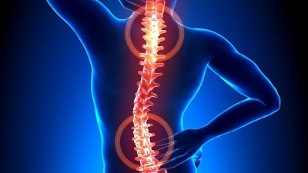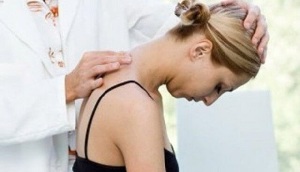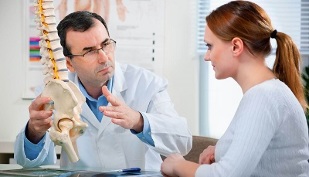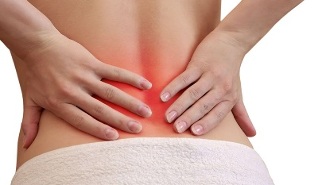Excessive tension in the back muscles causes a lot of discomfort and pain. Osteochondrosis, which causes a violation of the structure of vertebrae and intervertebral discs, leads to severe tightening of nerve endings. Often, the pathology is accompanied by a deterioration in blood circulation, which causes disturbances in the nutrition of the brain and internal organs.
Osteochondrosis - what is it?

Osteochondrosis is a type of recurrent disease that occurs in a chronic way and is accompanied by the destruction of the vertebrae with the intervertebral discs. Their tissues are disturbed, which causes a decrease in the degree of their elasticity, followed by a change in shape. There is a gradual decrease in the intervertebral space. This causes a loss of spinal stability in areas of pathological development.
The pathological tissue destruction processes occur against the compressed nerve endings, which are directed from the area where the spinal cord is located. As a result, the back muscles are in constant tension. In such a situation, patients complain of back pain and other symptoms.
Based on the peculiarities of the location of the spine structures, which were covered by degenerative changes, the cervical, thoracic and lumbosacral types of the pathological process are distinguished. The main symptom of the development of osteochondrosis is pain, the intensity and severity of which usually increase during physical exertion.
There is also rigidity in movement. In addition, the clinical picture is characterized by the presence of signs of the vertebral type - headaches, changes in blood pressure, deterioration of visual, auditory function and so on.
Development mechanism
The development of osteochondrosis is associated with the fact that the nucleus pulposus begins to lose its hydrophilic qualities. This semi-liquid structure contains fibers of connective tissue and chondroitin, a gelatinous substance. In the process of development of the human body and its growth, the processes of reducing the vascular bed in the intervertebral discs are actively taking place. The nutrients are supplied in a diffuse manner, which manifests itself in the spontaneous stabilization of the concentration. This characteristic becomes the reason for difficulties in the complete restoration of the cartilage that has suffered damage or excessive pressure on the spine.
Pathological abnormalities become more marked due to violations of the hormonal basis and human nutrition. Cartilage tissue begins to lack the necessary nutrients for its normal development. Therefore, the disturbances appear in the form:
- decreased strength and elasticity;
- changes to consistency parameters and configuration properties.

In the context of the flattening of intervertebral discs, radial cracks form in the fibrous ring. As a result, the intervertebral distance is reduced and the joints start to move. Over time, pathological changes cover the types of connective tissue related to fibrous rings and ligaments.
As tissues are degraded by the immune system, larger amounts of immunoglobulins are produced. This causes the development of the aseptic inflammation process, edema is formed in the region where the joints are located. They also spread to adjacent soft tissues.
Due to the lengthening of the joint capsules, the intervertebral discs lose the ability to fix the vertebrae. This instability in the position of the spine structure increases the risks of pinching nerve roots or compressing blood vessels. This characteristic is typical, for example, of cervical osteochondrosis, which is accompanied by intense verbal symptoms.
Causes of the disease
The condition of the intervertebral discs may worsen with a decrease in the tone of the skeletal muscles of the spine. Due to the irrational and asymmetric work of the muscles, destruction of the cartilaginous tissues can occur with the prolonged preservation of the body's non-physiological position. This violation is due to the use of heavy bags on the same shoulder, using soft mattresses and high pillows.
The destruction process of intervertebral discs is accelerated due to the action of a series of negative factors of an external and internal nature. This includes:
- disorders
- in the endocrine mechanism and metabolic disorders;
- pathologies of an infectious nature, including chronic ones;
- spinal injuries in the form of compression fractures, bruises;
- regular and prolonged hypothermia of the body;
- systemic and degenerative-dystrophic diseases - gouty, psoriatic, rheumatoid arthritis, osteoporosis, osteoarthritis;
- smoking and alcohol abuse, which disturbs the state of the vascular system, impairs blood circulation and causes a lack of nutrients in the cartilage;
- insufficient physical development, posture problems, flat feet - these defects increase the load on the spine, as the amortization will be insufficient;
- obesity;
- genetic predisposition;
- exposure to regular stress.
Symptoms

The main clinical sign of osteochondrosis of any location (cervical, thoracic or lumbosacral) is pain syndrome. With a relapse, the pain is penetrating, radiating to areas close to the body. Even with a slight movement, it intensifies. This forces the patient to place the torso in a forced position to minimize discomfort and pain:
- with cervical osteochondrosis, it is preferable to turn not a head, but the whole body;
- when there is a chest form of the disease, it is difficult for the patient to take a deep breath and therefore, to exclude acute chest pain, he tries to minimize the depth and frequency of breathing;
- in patients with a type of lumbar disease, difficulties arise when they sit, take an upright position, move, when the nerve of the spinal location is pinched.
Usually, patients complain about the presence of dull and persistent pain and a feeling of stiffness in their movements in the morning after waking up. In that case, differential diagnosis will be necessary to help rule out the risks of developing myositis caused by inflammation of the skeletal muscles of the spine or osteoarthritis.
Painful and pressing pain occurs due to compensatory tension in muscle tissues. This condition is necessary to stabilize the movement area of the spine. Mild or moderate constant pain can appear with significant stretching of the intervertebral disc and result from aseptic inflammatory changes.
Osteochondrosis of a separate location is characterized by special symptoms:
- In cervical osteochondrosis, pain is felt in the cervical area, in the upper limbs. Headaches and numbness in the fingers are observed. If the disease manifests itself seriously, clamping of the vertebral artery may occur. In this case, the patient begins to complain of a significant deterioration in health.
- The chest location is manifested by acute and painful back pain, the visceral pain syndrome is present in the cardiac region, right hypochondrium and abdomen. Patients complain of numbness, skin paresthesia, shortness of breath, tightness in the vertebrae.
- Patients with lumbar osteochondrosis complain of pain in the back and lower extremities with increased intensity when moving. Frequently, disorders in the functioning of the organs of the genitourinary system, problems with male potency, dysfunctional ovarian disorder are diagnosed. During remission, the pain may subside. However, the impact of a provocative factor leads to its renewal.
- When mixed osteochondrosis manifests, the symptoms can manifest in several zones at the same time. This condition is characterized by a more severe course of the disease.

It must be remembered that the displacement of the vertebrae and the formation of osteophytes cause compression of the vertebral artery. It nourishes the brain by providing its cells with an oxygen component. When squeezed, food is limited and therefore the patient has problems with motor coordination, headaches, tinnitus and high blood pressure.
Consequences if not treated
The reason for the complicated course of osteochondrosis is the relatively rapid formation of hernias in the intervertebral discs. Its appearance is associated with the displacement of the vertebral structure in the posterior direction. This causes a rupture of the posterior ligament of the longitudinal type, which results in instability of the position of the disc, protrusion of its individual cuts to the region of the vertebral canal. The hernia rupture occurs when a disk with a pulpy nucleus penetrates the canal area.
With the manifestation of pathological abnormalities in the vertebral structures, the posterior part of the brain begins to contract, the patient develops discogenic myelopathy. The symptoms of this condition are associated with numbness and weakness in certain muscle groups in the upper and lower extremities. Paresis, muscle atrophy and tendon reflexes are manifested. In some cases, there are problems with emptying the bladder, with the intestines.
Herniated discs are dangerous when compressing the arteries that supply the spinal cord. The result of this pathology is the formation of ischemic zones, where nerve cells have suffered damage and death. The manifestation of a neurological effect is expressed in dysfunctions of motor function, a drop in the degree of tactility and a disturbance of trophism.
Diagnosis of diseases

The initial diagnosis is made based on the patient's complaints and existing symptoms. The specialist studies the condition of the spine in different positions, suggesting that the patient is at rest or in movement. In the next step, the patient is referred for laboratory diagnosis, which will help to clarify or refute the diagnosis.
The search methods used include:
- Radiography- provides a complete examination of the spine with an assessment of the condition of the vertebrae, existing disorders in the form of growths, curvatures. The specialist will be able to determine the intervals of the intervertebral type, the state of the holes. To accurately identify osteochondrosis, located in the chest or cervical region, a two-stage X-ray examination is performed. In the first stage, the patient lies on his side and, in the second, directly on his back.
- The method of magnetic resonance tomography or computed tomographyprovides highly informative data, which help to study the vertebrae in detail without interfering with the shape of the organs that cover them. The image shows the nerves and the vascular system. Magnetic resonance imaging helps to identify the signs of many diseases of the spine and the location of the damage. With CT, hernias are visualized, possible deviations in the structure of the spine are determined.
- Laboratory examinationto assess the state of the blood and its main parameters. It allows clarifying the diagnosis and determining the possibility of developing concomitant diseases.
In many cases, as a result of examinations, doctors diagnose the presence of some underlying diseases, potentially dangerous due to their complications. We are talking, for example, of hernias, protrusion, radiculitis. Correct diagnosis of problems helps to effectively treat osteochondrosis. At the same time, the disease itself in the early stages of development is disguised as the symptoms of other diseases.
Therapeutic process
Osteochondrosis is treated conservatively or with surgery. The choice depends on the severity of the condition, its neglect, the level of tissue deterioration and the causes.
It is important to remember that it is not possible to completely cure osteochondrosis, as there are no drugs to help completely restore the discs and vertebrae. The therapeutic effect is focused on inhibiting the destruction process and increasing the duration and stability of remission.
For symptomatic therapy, chondroprotectors are used, which are based on chondroitin sulfate or glucosamine.
The effectiveness of the therapeutic process with the use of chondroprotectors has been clinically confirmed based on long-term tests. If you take these funds for a long period of 3 months, then there is a partial restoration of the cartilage and other elements of the connection type - the ligament tendon apparatus, bursa.

The accumulation of glucosamine and chondroitin in the area of the intervertebral disc leads to the manifestation of analgesic, anti-edematous and anti-inflammatory effects. Therefore, there is a real opportunity to optimize the dosage of NSAIDs, drugs in the group of glucocorticosteroids, muscle relaxants. You can count on a decrease in the burden of medication on the patient.
The effectiveness of chondroprotectors is determined by the regularity of their intake. Otherwise, there will be no result. Ineffectiveness is also recorded in the treatment of 3rd degree osteochondrosis, accompanied by significant destruction of cartilage.
The following groups of drugs can be used to relieve pain:
- Non-steroidal anti-inflammatorieshelp eliminate inflammatory disorders in the soft tissues caused by spinal displacement. NSAIDs are effective in reducing pain, swelling and stiffness.
- Means of the glucocorticosteroid group- generally the blocks are used in conjunction with an anesthetic. They are able to relieve pain, restore the immune mechanism and provide an anti-exudative effect.
- Muscle relaxants.They are effective in fighting muscle spasms due to nerve compression. They help to relax the skeletal muscles and block polysynaptic spinal reflexes with an antispasmodic effect.
- External remedies with a heating effect.Irritation of subcutaneous tissue receptors with activation of blood flow is provided by special gels and ointments. These drugs have analgesic and anti-edematous effects.
It is possible to eliminate vertebrogenic symptoms, which manifest themselves from the location of the pathology in the cervical or thoracic area, with the aid of medical devices to activate blood flow. Nootropics and medications to improve microcirculation are also prescribed. In some cases, it may be necessary to take antidepressants, as well as medications with anticonvulsants.
During the treatment of osteochondrosis, physical therapy is also used. Procedures for UHF therapy, magnetotherapy, laser therapy, reflexology, massage, exercise therapy, hirudotherapy, as well as swimming and yoga can be prescribed. If conservative treatment is ineffective, the operation is performed by means of microdiscectomy, puncture of the disc, laser reconstruction or implant replacement.



































